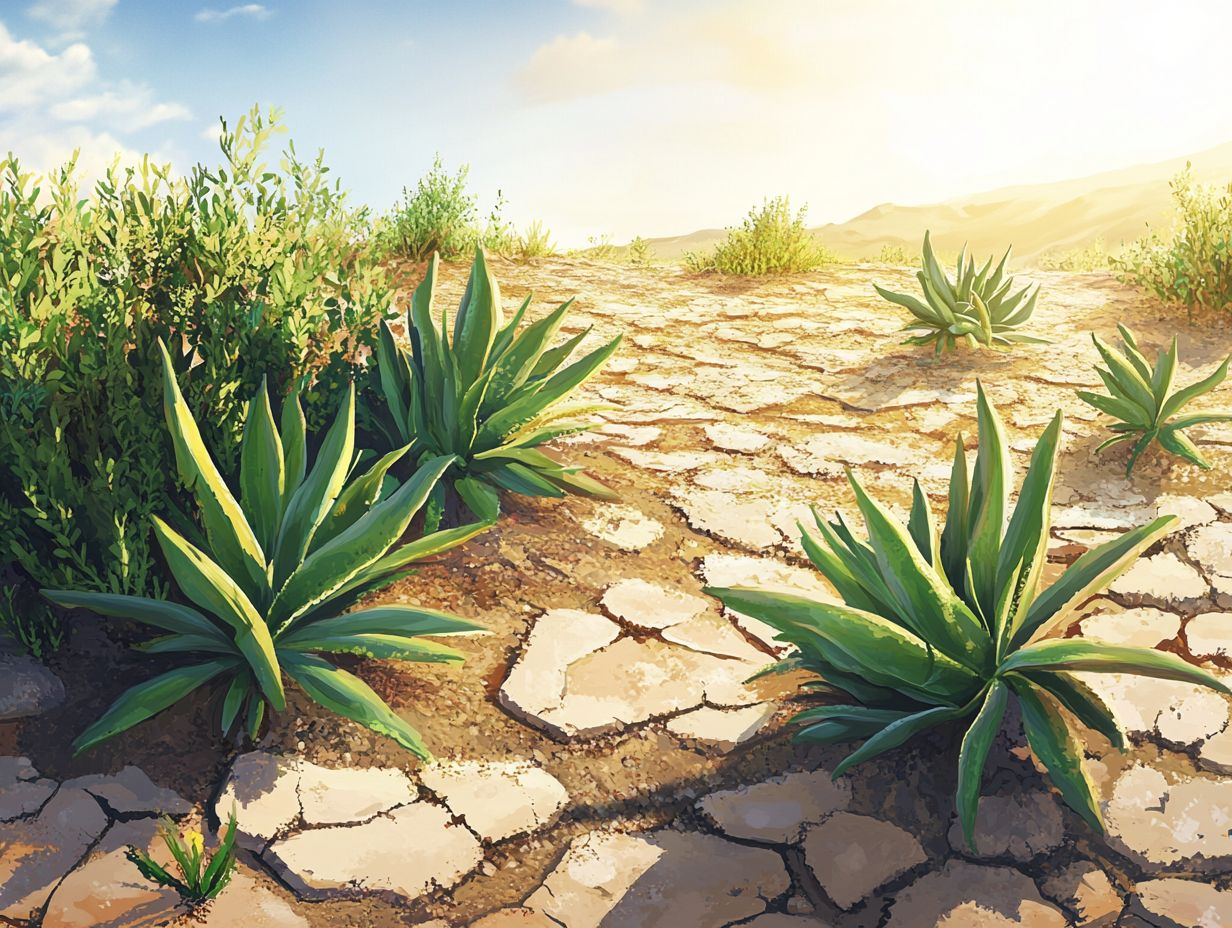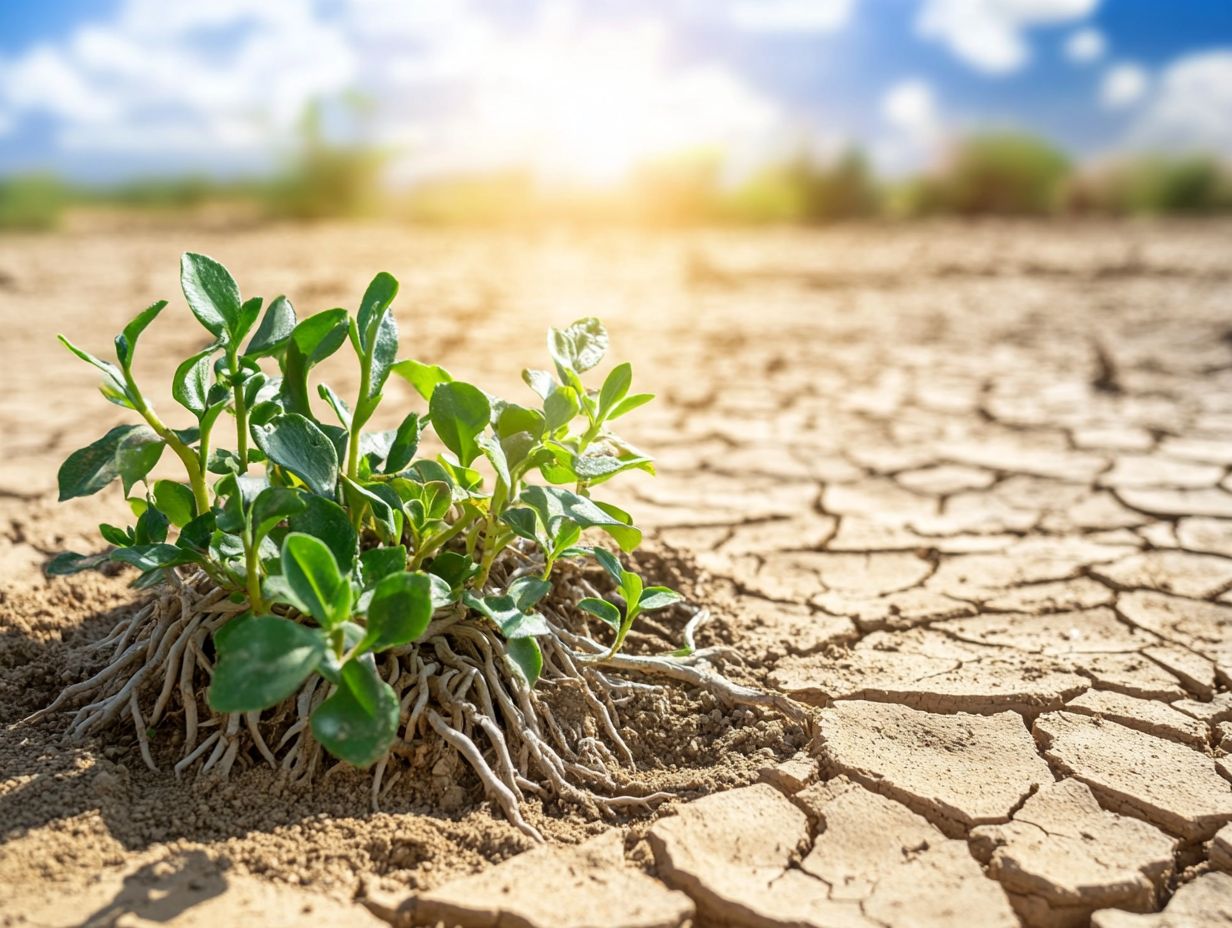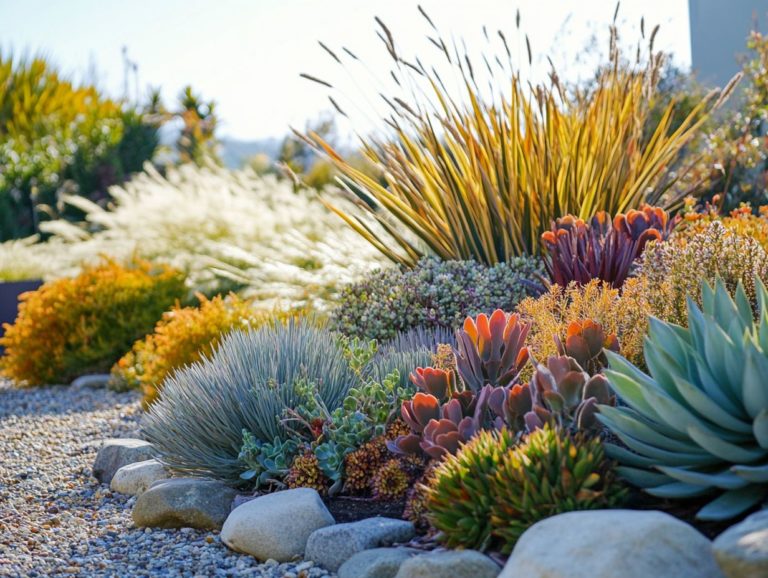Understanding Drought Resistance in Plant Species
Drought resistance allows plants to thrive in dry conditions. This quality is increasingly vital in our changing climate.
This article will take you on a journey to explore the fascinating world of drought resistance. You will discover the many genetic and environmental factors that contribute to this remarkable ability.
Learn about the physical changes in how drought-resistant plants function, discover specific species known for their resilience, and grasp the critical role this trait plays in agriculture and food security.
You will find innovative strategies in breeding and biotechnology focused on enhancing drought resistance. This paves the way for a sustainable future in crop production.
Dive in to uncover the intriguing world of drought-resistant plants and their profound significance in your life.
Contents
Key Takeaways:

- Drought resistance is the ability of plants to survive and thrive in dry conditions, making them crucial for agricultural sustainability.
- Genetics and environmental factors play a significant role in determining a plant’s drought resistance. Understanding these factors can aid in developing more resilient crops.
- Physical changes, such as reduced water loss and deeper root systems, are key traits of drought-resistant plants. These traits can be targeted for improvement through breeding and biotechnology approaches.
What is Drought Resistance?
Drought resistance is the remarkable ability of plants to withstand and adapt to water scarcity and drought conditions. Through intricate physiological processes, these plants manage to reduce water loss while striving to maintain crop yield.
This adaptive capacity is vital in agriculture, especially in regions facing escalating water shortages from climate change. By understanding drought resistance, you can help develop effective agricultural practices and breeding strategies that improve crop productivity even during drought stress.
Defining the Concept
Drought resistance encompasses various plant responses that enable survival during periods of water deficit. This term highlights the innate characteristics of certain species that allow them to maintain physiological functions despite limited water availability.
Drought tolerance is a broader concept, including both inherent features and the plant’s ability to recover and adapt over time after drought stress. Key physiological traits are essential in these processes.
For instance, when a plant detects moisture loss, it often initiates stomatal closure to reduce water loss through transpiration, a key response for managing water deficit.
Many plants develop extensive root systems to access deeper soil moisture, enhancing their drought resilience. Understanding these mechanisms is crucial for selecting and breeding drought-resistant varieties in agriculture, promoting stress tolerance and improving crop yield.
Factors Affecting Drought Resistance
Drought resistance in plants results from a complex interplay of genetic and environmental factors that shape their response to water scarcity. Recognizing these relationships is essential for advancing agricultural practices and enhancing crop resilience.
Genetics and Environmental Factors
Genetics plays a key role in determining the drought resistance of various plant species. Specific gene expressions influence essential physiological traits and hormonal pathways that affect stress severity.
These traits root depth, leaf structure, and stomatal conductance are essential for how plants navigate limited water availability. They significantly contribute to drought coping strategies. The dynamic interplay between genetic makeup and environmental conditions impacts gene expression, leading to varied responses to drought stress.
For example, under arid conditions, certain genes may activate pathways that enhance water retention or boost photosynthetic efficiency.
By understanding how these genetic mechanisms function, you can help pave the way for developing more resilient crops, which is a fundamental aspect of sustainable agriculture amidst climate challenges.
Adaptations of Drought-Resistant Plants

Drought-resistant plants showcase an impressive array of physical and physiological adaptations that enable them to endure extended periods of water scarcity. These traits help plants survive and recover quickly from drought.
Physical and Physiological Adaptations
Physical adaptations, such as modified leaf structures and an extensive root system, paired with physiological traits like enhanced water uptake, play a significant role in your plant’s drought resilience.
Certain species have thicker cuticles that effectively minimize water loss. Others might develop smaller or curled leaves to reduce the surface area exposed to the sun. Adaptations like increased stomatal conductance help improve CO2 exchange during cooler parts of the day, which is crucial for sustaining photosynthesis even under water-limited conditions.
Specialized mechanisms allow these plants to manage carbon resources during drought, ensuring their survival and enabling recovery.
Plant Species with High Drought Resistance
Several plant species, such as Arabidopsis thaliana, are celebrated for their remarkable drought resistance. These plants possess unique genetic traits that significantly bolster their capacity to withstand water scarcity, ensuring crop yield.
Examples and Characteristics
Common examples of drought-resistant plants include succulents the water-storing plants you might have at home and certain species of grasses, each showcasing unique traits that enable them to thrive in arid conditions.
Take the Agave plant, for instance. With its thick, fleshy leaves, it effectively stores water and flourishes in dry environments, showcasing its adaptations to combat drought impact. Native grasses like switchgrass boast deep root systems that access moisture well below the surface, making them outstanding choices for sustainable farming practices.
These plants not only withstand limited water availability but also enhance soil health by preventing erosion and maintaining nutrient levels through microbial biotechnology. Incorporating such resilient species into your crop rotation and intercropping systems strengthens agricultural resilience, ensuring a steady yield even amid increasingly unpredictable climate conditions, which is crucial for food security.
Importance of Drought Resistance in Agriculture
Drought resistance is vital for sustainable agriculture, profoundly influencing crop production and food security amid escalating environmental challenges and the realities of climate change.
Explore the incredible world of drought-resistant plants! Act now to secure our food supply for the future!
Impact on Crop Production and Food Security

The impact of drought resistance on crop production is immense. It directly shapes food security and the sustainability of agricultural practices.
By enabling crops to withstand prolonged dry spells, improved drought tolerance not only aids in maintaining yields but also stabilizes supply chains. In regions often affected by water scarcity, the ability of crops to flourish under challenging conditions becomes essential.
You can significantly enhance agricultural output by employing strategies such as:
- drought-resistant seed varieties
- efficient irrigation techniques
- soil moisture conservation practices
Implementing these methods fosters resilience among farmers. It promotes sustainable land management, ensuring that communities continue to access reliable food sources even amid climatic challenges.
Strategies for Improving Drought Resistance
Enhancing drought resistance in crops requires a combination of breeding techniques and cutting-edge biotechnology approaches. These are designed to help crops survive challenging drought conditions.
By integrating these methods, you can significantly improve the adaptability of crops, ensuring they thrive even in the face of water scarcity.
Breeding and Biotechnology Approaches
Breeding and biotechnology approaches focus on enhancing genetic traits linked to drought resilience. The aim is to develop robust crop varieties that can withstand challenging conditions, including those affected by non-living factors like drought.
Techniques such as marker-assisted selection make it easier to find plants with desired traits. This accelerates breeding cycles and enables more precise improvements and understanding of molecular mechanisms. Genetic engineering plays a crucial role in this process, allowing scientists to directly insert genes that confer drought resistance into crop genomes.
For example, the development of drought-tolerant maize varieties through biotechnology has yielded promising results. It has contributed to improved yield stability in arid regions.
These advancements can enhance agricultural productivity and represent a sustainable pathway forward. They enable farmers to adapt to climate variability while safeguarding food security for future generations.
Frequently Asked Questions
What is drought resistance in plant species?
Drought resistance in plant species is the ability of a plant to survive and thrive in conditions of limited water availability. This includes both prolonged periods of little to no water and short-term drought events, as explained in detail in what are the key features of drought-resistant plants?
Why is understanding drought resistance important?

Understanding drought resistance is crucial for plant species because it allows them to survive in challenging environments. This, in turn, has important implications for agriculture and food security, as plants with high drought resistance can still produce crops in areas prone to drought. For more insights, consider understanding the benefits of drought-tolerant species.
How do plants develop drought resistance?
Plants can develop drought resistance through a variety of mechanisms. These include adjusting their root systems to reach deeper sources of water, reducing the size of their leaves to limit water loss, and producing protective compounds to cope with water stress. Some plants also have genetic adaptations that allow them to thrive in drought conditions.
Are all plant species equally drought resistant?
No, plant species vary in their ability to withstand drought. Some species, such as cacti and succulents, have evolved to thrive in arid environments and are highly drought resistant. Others, like grasses, have lower drought resistance and may struggle to survive in prolonged drought conditions.
Explore how you can support drought-resistant farming today!
Can plants lose their drought resistance?
Yes, plants can lose their drought resistance. This happens if they receive plenty of water consistently and never face drought. Without drought conditions, they don’t develop the skills needed to survive with less water.
To keep plants drought-resistant, it’s important to let them experience dry conditions occasionally.
How can I help improve drought resistance in plant species?
You can improve drought resistance by selecting and planting species that naturally withstand dry conditions. Adopt sustainable watering practices and manage land responsibly to prevent erosion and water loss.
Supporting conservation efforts and cutting down on water use also helps boost plants’ drought resistance.






